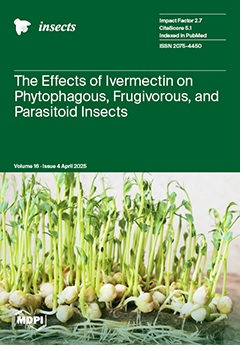View Item
- xmlui.general.dspace_homeCentros Regionales y EEAsCentro Regional Entre RíosEEA ConcordiaArtículos científicosxmlui.ArtifactBrowser.ItemViewer.trail
- DSpace Home
- Centros Regionales y EEAs
- Centro Regional Entre Ríos
- EEA Concordia
- Artículos científicos
- View Item
More than Just Host Plant Preferences for the Two Main Vectors of Xylella fastidiosa in Europe: Two Insect Species and Two Different Behaviors
Abstract
Xylella fastidiosa is a vector-borne bacterium causing significant economic losses in global agricultural industries. Management strategies focus primarily on controlling vector populations. The diversity of vector species, their polyphagy, and the wide range of host plants supporting bacterial development make X. fastidiosa pathosystems particularly challenging to manage. Understanding vector and host plant relationships is key to developing effective
[ver mas...]
Xylella fastidiosa is a vector-borne bacterium causing significant economic losses in global agricultural industries. Management strategies focus primarily on controlling vector populations. The diversity of vector species, their polyphagy, and the wide range of host plants supporting bacterial development make X. fastidiosa pathosystems particularly challenging to manage. Understanding vector and host plant relationships is key to developing effective strategies. This study examined the oviposition strategies, host preferences, and nymphal development of Europe’s main X. fastidiosa vectors, Philaenus spumarius and Neophilaenus campestris, under semi-field conditions (screenhouse). The two species exhibited distinct behaviors. Neophilaenus campestris primarily laid eggs on its preferential host, the grass Festuca arundinacea, while P. spumarius preferred dry soil substrates, irrespective of the host plant species. The presence of multiple hosts reduced the oviposition rates of P. spumarius compared with single-host scenarios. The nymphs of P. spumarius quickly identified and settled on preferential hosts, while the N. campestris nymphs initially moved randomly but later congregated on their preferred host. Despite their polyphagy, nymph survival was limited to preferential hosts. These findings highlight opportunities for habitat management strategies, such as enhancing plant diversity and eliminating overwintering egg sites, to mitigate vector populations and limit the spread of X. fastidiosa.
[Cerrar]

Author
Bernat-Ponce, Saul;
García-García, Rosalía;
Aure, Cristina M.;
Nieves-Carretero, Lorena;
Bouvet, Juan Pedro;
Beitia, Francisco José;
Monzó Ferrer, César;
Fuente
Insects 16 (4) : 416. (April 2025)
Date
2025-04
Editorial
MDPI
ISSN
2075-4450
Formato
pdf
Tipo de documento
artículo
Palabras Claves
Derechos de acceso
Abierto
 Excepto donde se diga explicitamente, este item se publica bajo la siguiente descripción: Creative Commons Attribution-NonCommercial-ShareAlike 2.5 Unported (CC BY-NC-SA 2.5)
Excepto donde se diga explicitamente, este item se publica bajo la siguiente descripción: Creative Commons Attribution-NonCommercial-ShareAlike 2.5 Unported (CC BY-NC-SA 2.5)


